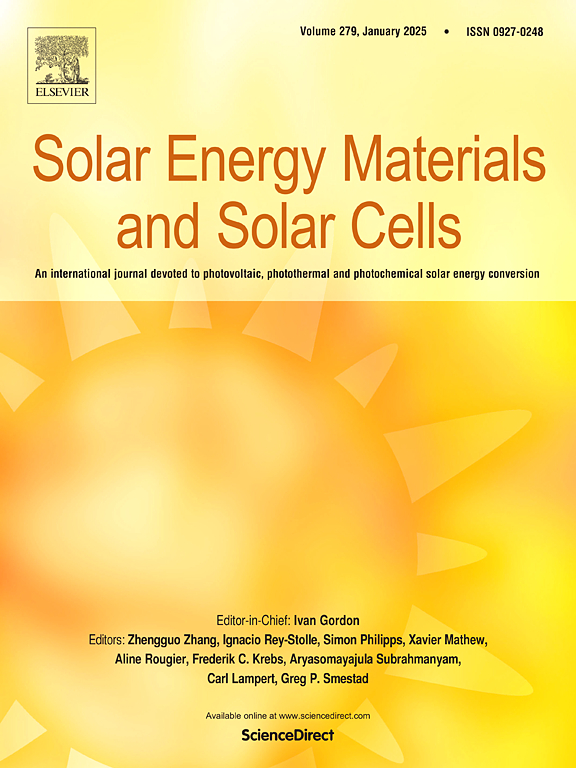Flexible GaInP/Ga(In)As/Ge triple-junction space solar cells with a simple fabrication process based on Ge substrate thinning demonstrate power-to-mass ratios of 1.3 kW/kg
IF 6.3
2区 材料科学
Q2 ENERGY & FUELS
引用次数: 0
Abstract
One the primary strategies in space photovoltaics is the development of flexible and lightweight solar cells with a high specific power. Rigid lattice-matched GaInP/Ga(In)As/Ge 3 J solar cells with a thickness of ∼150 μm for 100 mm (4-inch) Ge substrates with a power-to-mass ratio of 0.47 kW/kg currently represent the benchmark for space solar cells. This paper analyses the performance of these 3 J solar cells as a function of Ge substrate thickness under various scenarios of both front and back surface recombination velocity of the Ge subcell. In order to validate the modelling results, we manufactured GaInP/Ga(In)As/Ge 3 J solar cells thinned down to 50 μm from an original thickness of 150 μm following the same fabrication procedures as conventional thick cells and without back surface passivation nor back reflectors. Remarkably, the efficiency of the thinned cells is the same than the non-thinned ones, closely aligning the model predictions. We demonstrate a power-to-mass ratio of 1.3 kW/kg, despite the semiconductor structure not being optimized for the AM0 spectrum. Finally, we outline potential pathways for improving the performance of these 3 J solar cells to achieve nearly 2 kW/kg.
基于Ge衬底薄化的柔性GaInP/Ga(In)As/Ge三结空间太阳能电池的功率质量比为1.3 kW/kg
空间光伏发电的主要策略之一是开发具有高比功率的柔性轻量化太阳能电池。刚性晶格匹配GaInP/Ga(In)As/ ge3j太阳能电池,厚度为~ 150 μm,用于100 mm(4英寸)Ge衬底,功率质量比为0.47 kW/kg,目前代表了空间太阳能电池的基准。本文分析了在不同的锗亚电池前后表面复合速度下,这3种J型太阳能电池的性能随锗衬底厚度的变化规律。为了验证建模结果,我们制造了GaInP/Ga(In)As/ ge3j太阳能电池,从原始厚度150 μm减薄到50 μm,遵循与传统厚电池相同的制造过程,并且没有背面钝化和背面反射器。值得注意的是,变薄的电池的效率与未变薄的电池相同,与模型预测非常吻合。我们展示了1.3 kW/kg的功率质量比,尽管半导体结构没有针对AM0光谱进行优化。最后,我们概述了提高这些3j太阳能电池性能以达到近2 kW/kg的潜在途径。
本文章由计算机程序翻译,如有差异,请以英文原文为准。
求助全文
约1分钟内获得全文
求助全文
来源期刊

Solar Energy Materials and Solar Cells
工程技术-材料科学:综合
CiteScore
12.60
自引率
11.60%
发文量
513
审稿时长
47 days
期刊介绍:
Solar Energy Materials & Solar Cells is intended as a vehicle for the dissemination of research results on materials science and technology related to photovoltaic, photothermal and photoelectrochemical solar energy conversion. Materials science is taken in the broadest possible sense and encompasses physics, chemistry, optics, materials fabrication and analysis for all types of materials.
 求助内容:
求助内容: 应助结果提醒方式:
应助结果提醒方式:


